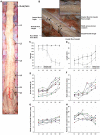The Role of Functional Neuroanatomy of the Lumbar Spinal Cord in Effect of Epidural Stimulation
- PMID: 29075183
- PMCID: PMC5642185
- DOI: 10.3389/fnana.2017.00082
The Role of Functional Neuroanatomy of the Lumbar Spinal Cord in Effect of Epidural Stimulation
Abstract
In this study, the neuroanatomy of the swine lumbar spinal cord, particularly the spatial orientation of dorsal roots was correlated to the anatomical landmarks of the lumbar spine and to the magnitude of motor evoked potentials during epidural electrical stimulation (EES). We found that the proximity of the stimulating electrode to the dorsal roots entry zone across spinal segments was a critical factor to evoke higher peak-to-peak motor responses. Positioning the electrode close to the dorsal roots produced a significantly higher impact on motor evoked responses than rostro-caudal shift of electrode from segment to segment. Based on anatomical measurements of the lumbar spine and spinal cord, significant differences were found between L1-L4 to L5-L6 segments in terms of spinal cord gross anatomy, dorsal roots and spine landmarks. Linear regression analysis between intersegmental landmarks was performed and L2 intervertebral spinous process length was selected as the anatomical reference in order to correlate vertebral landmarks and the spinal cord structures. These findings present for the first time, the influence of spinal cord anatomy on the effects of epidural stimulation and the role of specific orientation of electrodes on the dorsal surface of the dura mater in relation to the dorsal roots. These results are critical to consider as spinal cord neuromodulation strategies continue to evolve and novel spinal interfaces translate into clinical practice.
Keywords: epidural stimulation; functional neuroanatomy; neuromodulation; spinal cord; swine.
Figures







References
LinkOut - more resources
Full Text Sources
Other Literature Sources

